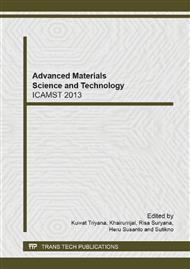p.455
p.459
p.464
p.468
p.472
p.477
p.481
p.485
p.489
Prelimenary Study on the Photovoltaic and Impedance Characteristics of Dye Sensitized Solar Cell (DSSC) using Polymer Gel Electrolyte
Abstract:
Dye sensitized solar cells (DSSC) have been fabricated by using polymer gel electrolyte consisting of ionic liquids in a composite polymers of siloxane and ethylene oxide groups. The structure of those DSSCs are ITO/Ti:ZnO/TiO2/Ru-dye/gel electrolyte/Pt/ITO, with active area of about 0,5 cm2. At this preliminary work, the structure parameters and fabrication procedures had not been optimized for achieving the best performance, but it had been carefully controlled to be same for all fabricated DSSCs. Those DSSCs shows the solar cell performance similar to that observed in DSSCs fabricated in the same cell structure but using conventional electrolyte solution. They exhibit better open voltage and filling factor, which is suggested to the reduction of charge carrier recombination probably taking place at the double layer region formed at the electrode interfaces. This is consistent with their impedance spectrum which is dominated by a Warburg-like characteristics indicating a diffusion limited migration process. It seems then the cell performances is improved by the reduction of charge recombination loss but restricted by diffusion limited ion migration process.
Info:
Periodical:
Pages:
472-476
Citation:
Online since:
February 2014
Price:
Сopyright:
© 2014 Trans Tech Publications Ltd. All Rights Reserved
Share:
Citation:



